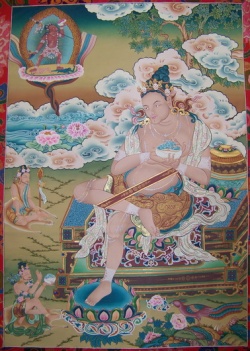Difference between revisions of "84 Mahasiddhas"
m (Text replacement - "songs " to "songs") |
|||
| Line 12: | Line 12: | ||
—[[Robert Thurman]] | —[[Robert Thurman]] | ||
| − | [[Mahasiddha]], ([[maha]] meaning "[[great]]" and [[siddha]] meaning "{{Wiki|adept}}") is a term for someone who [[embodies]] and cultivates [[siddhi]] of [[perfection]]. They are a type of {{Wiki|eccentric}} [[yogi]] in both [[Hinduism]] and [[Vajrayana Buddhism]]. [[Mahasiddhas]] were [[tantric]] practitioners, or [[tantrikas]] who had sufficient [[attainments]] to act as a [[guru]] or [[tantric master]]. A [[siddha]] is an {{Wiki|individual}} who, through the practice of [[sadhana]], attains the [[realization]] of [[siddhis]], [[psychic]] and [[spiritual]] {{Wiki|abilities}} and [[powers]]. Their historical influence throughout the [[Indic]] and [[Himalayan]] region was vast and they reached [[mythic]] proportions which is codified in their | + | [[Mahasiddha]], ([[maha]] meaning "[[great]]" and [[siddha]] meaning "{{Wiki|adept}}") is a term for someone who [[embodies]] and cultivates [[siddhi]] of [[perfection]]. They are a type of {{Wiki|eccentric}} [[yogi]] in both [[Hinduism]] and [[Vajrayana Buddhism]]. [[Mahasiddhas]] were [[tantric]] practitioners, or [[tantrikas]] who had sufficient [[attainments]] to act as a [[guru]] or [[tantric master]]. A [[siddha]] is an {{Wiki|individual}} who, through the practice of [[sadhana]], attains the [[realization]] of [[siddhis]], [[psychic]] and [[spiritual]] {{Wiki|abilities}} and [[powers]]. Their historical influence throughout the [[Indic]] and [[Himalayan]] region was vast and they reached [[mythic]] proportions which is codified in their songsof [[realization]] and {{Wiki|hagiographies}}, or [[namthar]], many of which have been preserved in the [[Tibetan Buddhist canon]]. The [[Mahasiddha]] are [[acknowledged]] as the founders of many [[Indian]] and [[Buddhist traditions]] and [[lineages]]. |
</poem> | </poem> | ||
{{R}} | {{R}} | ||
[https://plus.google.com/100976413180507737790/posts/hYG63gaDd5C plus.google.com] | [https://plus.google.com/100976413180507737790/posts/hYG63gaDd5C plus.google.com] | ||
[[Category:Mahasiddhas]]{{BuddhismbyNumber}} | [[Category:Mahasiddhas]]{{BuddhismbyNumber}} | ||
Latest revision as of 19:05, 15 December 2015
"I call them the "psychonauts" of the tradition, in parallel with our “astronauts,” the materialist scientist-adventurers whom we admire for their courageous explorations of the “outer space” which we consider the matrix of material reality. Inverse astronauts, the psychonauts voyaged deep into “inner space,” encountering and conquering angels and demons in the depths of their subconscious minds."
—Robert Thurman
Mahasiddha, (maha meaning "great" and siddha meaning "adept") is a term for someone who embodies and cultivates siddhi of perfection. They are a type of eccentric yogi in both Hinduism and Vajrayana Buddhism. Mahasiddhas were tantric practitioners, or tantrikas who had sufficient attainments to act as a guru or tantric master. A siddha is an individual who, through the practice of sadhana, attains the realization of siddhis, psychic and spiritual abilities and powers. Their historical influence throughout the Indic and Himalayan region was vast and they reached mythic proportions which is codified in their songsof realization and hagiographies, or namthar, many of which have been preserved in the Tibetan Buddhist canon. The Mahasiddha are acknowledged as the founders of many Indian and Buddhist traditions and lineages.
